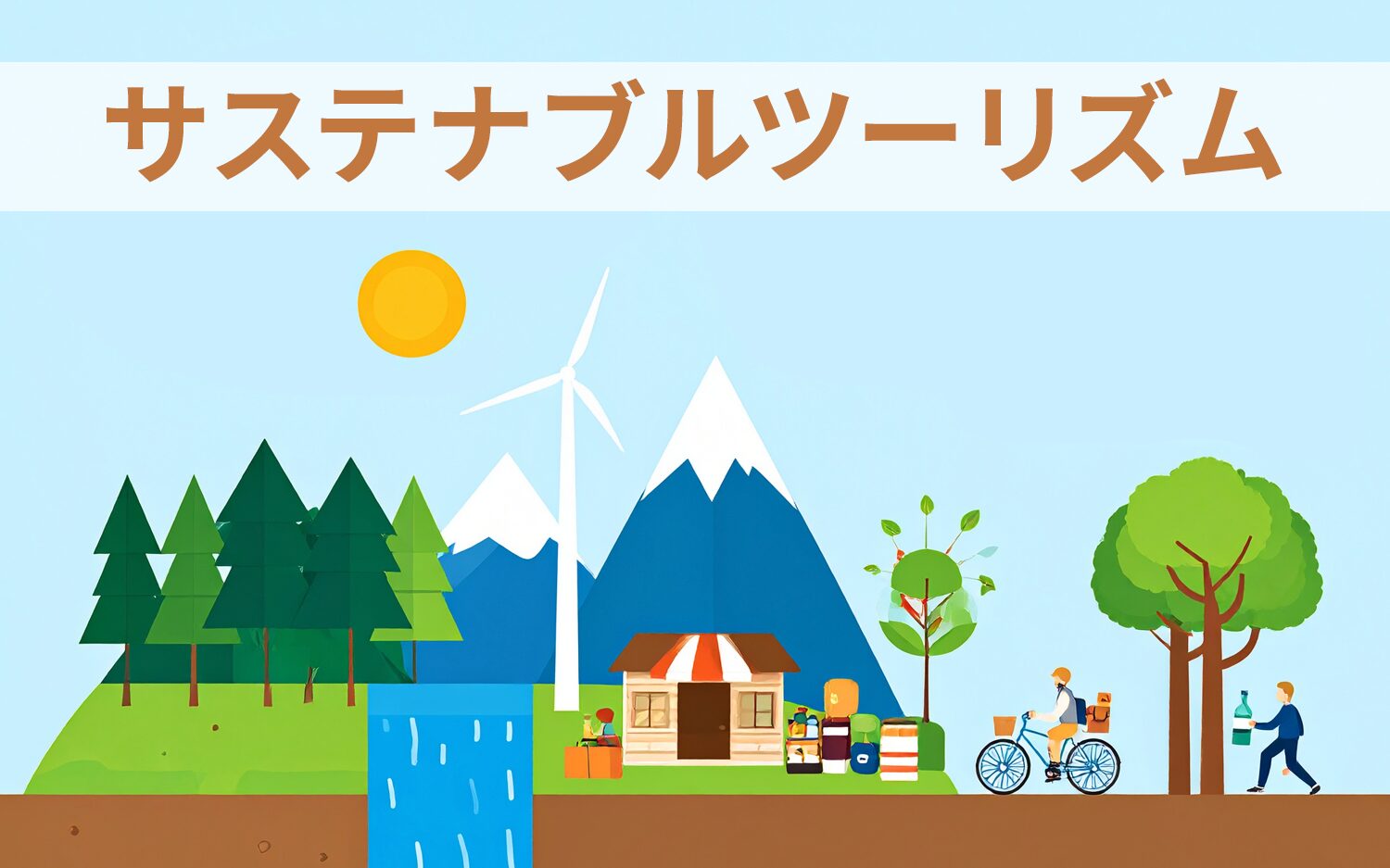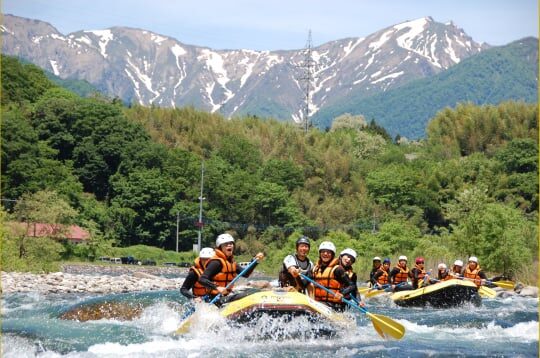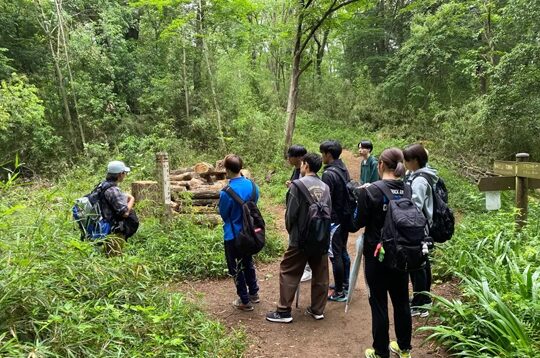Four examples of sustainable tourism to create sustainable communities through tourism
2025/05/20

As the negative aspects of tourism around the world become apparent, such as the destruction of nature, the loss of local culture, and massive carbon emissions, it is now time for the "Sustainable TourismThe idea of "the new world" is attracting a lot of attention.
Sustainable tourism is not about undermining the sustainability of the local nature, culture, economy, and society through tourism,Rather, it refers to the way tourism should be protected and supported!。
The United Nations World Tourism Organization (UNWTO) defines sustainable tourism as follows
Sustainable tourism is tourism that takes full account of its current and future economic, social, and environmental impacts while addressing the needs of visitors, the industry, the environment, and the communities that host them."
This concept, which goes beyond mere "eco-friendly tourism" and seeks to reconstruct the very relationship between local communities and travelers, is now becoming one of the central themes of tourism policies, traveler needs, and corporate strategies around the world.
This article will systematically explain the definition of sustainable tourism, the challenges it faces, and its future prospects, with examples of domestic and international practices.
Table of Contents
- 1 Four Practical Examples of Sustainable Tourism
- 1.1 Case Study 1: Minakami Town, Gunma Prefecture: "Experience-based Ecotourism" utilizing nature and culture
- 1.2 Case Study 2: Hanno City, Saitama Prefecture: "Satoyama tourism model" through collaboration between the local government and private sector
- 1.3 Case Study 3: Kamiyama Town, Tokushima Prefecture: Redesigning the community and travel through art and IT
- 1.4 Case Study 4: Jokkmokk, Sweden: Ecotourism in Harmony with Indigenous Peoples
- 2 Sustainable tourism is "sustainable community development through tourism.
- 3 5 "Tourism" Differences Often Asked About
- 4 Three Challenges in Sustainable Tourism and Efforts to Solve Them
- 5 Future Prospects for Sustainable Tourism
- 6 Conclusion
Four Practical Examples of Sustainable Tourism
Sustainable tourism is not only a concept, but is already being practiced in Japan and abroad in a variety of forms, and here we will introduce four examples of communities promoting sustainable tourism.
Case Study 1: Minakami Town, Gunma Prefecture: "Experience-based Ecotourism" utilizing nature and culture
Minakami Town in Gunma Prefecture is a treasure trove of natural resources, with forests covering approximately 90% of the town.In addition to outdoor experiences such as rafting and trekking, local guides provide a full range of nature commentary and introductions to satoyama culture.In addition, tourism that emphasizes "learning and connection," which goes beyond mere sightseeing, is taking root in the region.
Rafting down the ◆Tone River

Source: Minakami UNESCO Eco Park
Minakami Town is,Registered as a "UNESCO Eco-Park" in 2017 and selected as an "SDGs Future City" in 2019and others, and is highly regarded both domestically and internationally for its sustainable tourism and regional development.
Reference: Minakami UNESCO Eco Park
Case Study 2: Hanno City, Saitama Prefecture: "Satoyama tourism model" through collaboration between the local government and private sector
Hanno City, which is conveniently located about an hour from Tokyo by train, has a rich forest environment.Ecotourism Promotion Model DistrictsThe city has also been designated as a "sustainable tourism destination" and focuses on sustainable tourism that makes the best use of local resources.
Forest therapy, wood-chopping, and activities using thinned woodThe system allows travelers to experience firsthand the value of satoyama while also contributing to the circular economy of the region.
◆Eco-tour around Mt.

Source: Hanno City Ecotourism and Eco-tour
In cooperation with local inns and NPOs,Lodging facilities utilizing closed schoolsThe company is also developing a new business model, which will help to achieve both sustainable regional revitalization and job creation.
Reference: Hanno City Ecotourism and Eco-tour
Case Study 3: Kamiyama Town, Tokushima Prefecture: Redesigning the community and travel through art and IT
In the town of Kamiyama, located in the mountains of Shikoku,Unique sustainable tourism is being developed through a fusion of art, IT, and community development.
Led by the NPO Green Valley"Tubularity Created"Through the efforts of theAttraction of corporate satellite offices and artist-in-residence programs has progressed.The project is creating a new flow of people and economies in the region.
◆Kamiyama Artist in Residence

*Source: Kamiyama project points Kamiyama-cho, Tokushima, Shikoku
Through interaction with local residents and experiences in the satoyama, tourists can explore ways to become involved as a "related population" that is not transient, and can directly contribute to the creation of a sustainable local community.
This initiative has been recognized by the Japan Tourism Agency and numerous media outlets.A New Model for Sustainable Tourism."It is featured as a
Case Study 4: Jokkmokk, Sweden: Ecotourism in Harmony with Indigenous Peoples
Jokkmokk, located on the Arctic Circle in northern Sweden, is a region where the indigenous Sami people live in harmony with nature, and travelers can experience the Northern Lights and reindeer herding,Visitors can experience the Sámi culture and environmental protection philosophy.
◆Yokmok Winter Market

※出典:Jokkmokk - Swedish Lapland
The Swedish government and tourism board have positioned these efforts as "exemplary examples of sustainable tourism," and the localTourism guidelines based on respect for culture and conservation of natureThe area combines cultural heritage and environmental education through tourism,It is one of the leading destinations for "symbiotic tourism" in Europe.
Reference: Jokkmokk - Swedish Lapland
Sustainable tourism is not just another style of tourism,It is a practice that creates a sustainable relationship between the local community, the natural environment, and travelers, where all three parties enjoy value together.The examples presented show that this philosophy is embodied in diverse approaches, regardless of size or location.
At first glance, these initiatives seem to be unique local movements based on their own specific contexts,In fact, there is a common concept and international framework for all of them.In the following sections, we will provide a detailed definition and background of sustainable tourism and related terms.
Sustainable tourism is "sustainable community development through tourism.
What is sustainable tourism?"Tourism that takes place in a manner that preserves and supports, rather than undermines, the natural, cultural, economic, and social sustainability of the region."of the
Internationally, the UNWTO (United Nations World Tourism Organization), a specialized agency of the United Nations, defines
◆Definition of Sustainable Tourism
Citation: World Tourism Organization Asia Pacific Regional Office
This philosophy does not just mean "environmentally friendly tourism,Restructuring of tourism as a whole with "sustainability" at its coreThe goal is to
◆Basic structure of sustainable tourism

This idea has gained international attention because of the negative aspects that have become apparent with the rapid expansion of the tourism industry。
For example, "overtourism," in which the overcrowding of tourist destinations interferes with the lives of residents, excessive commercialization of the natural environment and local culture, and worsening friction caused by tourism pollution, have been recognized as problems around the world.
Under these circumstances, there is a growing movement to redefine tourism as a means of solving local problems and creating value.
The Sustainable Development Goals (SDGs) adopted by the United Nations in 2015 also clearly state the need to "promote sustainable tourism" andSustainable tourism is not just a philosophy, but is now being internationally recognized as a concrete practical model that should be incorporated into actual tourism policies and regional management.
Sustainable Tourism Takes Off in Japan
Sustainable tourism is closely related to the following goals among the SDGs
◆Sustainable tourism and related SDG targets
Goal 11: "Create a community where people can continue to live."
Goal 12: "Responsibility to Create and Use
Goal 13: "Specific measures to address climate change."
International,UNWTO and the Global Sustainable Tourism Council (GSTC) have developed guidelines and evaluation indicators for sustainable tourism.The introduction of this technology has been progressing in many countries and regions, especially in Europe.
Mechanisms to evaluate and certify destinations in terms of sustainability are also expanding, influencing all policies, businesses, and traveler behavior.
Also in Japan,Japan Tourism Agency to Promote "Advanced Sustainable Tourism Content" Model Project from 2021The development of a framework at the national level is now in full swing.
In addition, local governments and"Tourism Regional Development Corporations (DMOs)."But efforts to balance the conservation of local resources with the promotion of tourism are gaining momentum, and practical moves are steadily spreading in Japan.
5 "Tourism" Differences Often Asked About
In recent years, a new form of tourism known as "00 Tourism" has emerged one after another, driven by changing values among travelers, diversifying social needs, and a growing awareness of the impact of tourism on local communities and the environment.
Among these diverse tourism styles,Sustainable tourism is a comprehensive concept that functions as a "super concept" for other tourism styles.and there is a lot of overlap with other forms of tourism.
Please see below for a summary of the five main tourism styles that are often confused with sustainable tourism.
◆Five tourism styles that are often confused with sustainable tourism
| Tourism Name | Main Features | Positioning in Sustainable Tourism |
| 1) Ecotourism | Small-scale, hands-on nature tourism with an emphasis on learning and preserving the natural environment. | One of the practice forms dedicated to the "environment." |
| (2) Responsible tourism | Tourism where travelers behave ethically and responsibly. | An approach that supports sustainable tourism from the level of individual behavior |
| 3) Universal Tourism | Tourism that can be enjoyed by everyone, regardless of age, gender, nationality, or disability. | Elements to ensure equity and inclusiveness in tourism and realize "no one is left behind" tourism. |
| 4) Barrier-free tourism | Tourism support focusing on physical and precision removal of barriers (barriers). | Practical approaches to realize universal tourism in concrete terms |
| 5) Overtourism | A phenomenon in which an area or region is adversely affected by an overabundance of tourists, also known as "tourism pollution. | Countervailing concept for sustainable tourism to avoid or solve this |
Thus, ecotourism and responsible tourism are,The philosophy of sustainable tourism practiced with a specific focus on individual themesIt can be viewed as a
On the other hand,Overtourism is "raising issues" andSustainable tourism is positioned as a measure and direction.
Also, universal and barrier-free tourism are,Tourism that excludes no one."In terms of,Important complementary concepts that ensure social inclusion (inclusiveness) of sustainable tourismIt can be said.
Next, we will discuss in detail the challenges faced in implementing sustainable tourism in the field.
Three Challenges in Sustainable Tourism and Efforts to Solve Them
Sustainable tourism is attracting attention as an ideal way of tourism that aims to harmonize local communities, the environment, and the economy. However, it is not easy to create an operational framework to incorporate the ideal into reality, and actual tourism sites face many contradictions and obstacles.
Below we focus on three of the most common challenges to sustainable tourism seen in the field.
Issue 1: Difficulty in balancing economic efficiency and
While sustainable tourism is attractive as a philosophy,There are many situations where the practice requires additional cost and effort.
Especially in the tourism industry, where short-term profitability is required, the managerial burden is often a high hurdle.
◆Factors of profit pressure
Costly to obtain sustainable certification and to retain professional personnel
∙ Small and medium-sized inns and stores have difficulty investing in sustainability.
In this way,How to balance sustainability and business profitabilityis a serious dilemma for many tourist destinations.
Balancing economics and sustainability is not easy, but in some regions and businesses,Effective solutions are being sought through ingenuity.
◆Innovation to achieve both value and efficiency
Example: Solar power generation, LED lighting, and insulation are installed in lodging facilities to reduce both environmental impact and utility costs.
Attractiveness" of local products and price pass-through
Example: Linking locally produced and consumed foods and crafts with tourism experiences, and presenting them as "added value" rather than simply increased costs.
Support for introduction of subsidies and certification programs
Example: Reduce the initial investment hurdle by utilizing subsidized programs of the Japan Tourism Agency and support measures of local governments.
Promotions that promote the value of sustainable experiences
Example: Attract value-oriented traveler segments by pushing "eco-friendly lodging" and "tours that give back to the community" as a brand up front.
These efforts are still only partially complete, though,Movement to redefine "sustainable" as a point of differentiation, rather than "sustainable = cost increase.will be necessary for sustainable tourism management in the future.
Issue 2: Gap between travelers' awareness and behavior
The understanding and cooperation of travelers themselves is essential to creating a sustainable tourist destination, but in reality,Consumer sentiment is strong: "I think it's a good thing, but I won't go out of my way to choose it.In many cases, the philosophy does not lead to action.
◆Factors that do not lead to consumer action
The options for local contribution and environmental considerations are difficult to compare.
The term "sustainable tourism" itself is not yet widespread.
In such a situation, even if tourism operators and communities implement sustainable initiatives, they will not be successful if they are not chosen by travelers,To encourage travelers to "notice" and "act".will be required.
How to encourage travelers to change their behavior,You will need to devise a way to clearly communicate "Why should I choose this trip?" and "What value can I expect from this trip?。
The traveler is not just a tourist consumer,Creating mechanisms to make people feel they are "actors" contributing to the community and environmentare required.
◆Innovation to turn empathy into action
Example: Incorporate into tours a mechanism that allows "contributing experiences" through travel, such as nature conservation activities and interaction with local residents, in order to achieve both satisfaction and awareness among travelers.
Selection support through "visualization" of value
Example: Labeling of accommodations with low environmental impact and community-based transportation, etc., to make it easy to see "where is sustainable" at a glance.
Storytelling through social networking and video
Example: Visually communicate local attractions and the stories behind the sightseeing experience to encourage travelers to choose a destination based on empathy.
Educational approach to young people
Example: Incorporate elements of learning about local issues and the SDGs into school and educational trips to foster awareness among future traveler groups.
Such ingenuity is,Choose not because it's cheap or convenient, but because it makes sense or you can relate to it.This will lead to the formation of a new image of the traveler.
Issue (3) Weakness of mechanisms to support initiatives
No matter how good the idea of sustainable tourism is, it is difficult to sustain it without the mechanisms and human resources to support it in many regions,Structural issues, such as insufficient institutional design and organizational structure, as well as a lack of human resources, are holding us back.。
◆Problems due to lack of mechanisms
There are not enough people in the region who can promote sustainable tourism.
The roles of local governments, DMOs (regional tourism development corporations), and other related organizations are unclear, and cooperation is not functioning well.
Options for certification and support programs are still limited.
Therefore, there is an urgent need to build a foundation for sustainable sustainable tourism.
How to turn a philosophy into a "system",Systems, evaluation axes, human resource development, and collaboration systems that work in the fieldand other innovations are needed.
◆Innovation to support the philosophy
Example: In addition to the number of overnight stays and the amount of tourism consumption, develop a system to quantitatively evaluate sustainable perspectives, such as local return rates and reductions in environmental impact.
Promote the development and placement of specialized personnel
Example: Develop and deploy personnel with a cross-sectional understanding of tourism, the environment, and regional management to strengthen on-site promotion capabilities.
Establish a platform for collaboration between the public and private sectors and between regions.
Example: Establish a regular forum where local governments, DMOs, and tourism businesses can discuss and share their visions on an equal footing.
Promote the use of support measures and certification programs
Example: Publicize and support existing subsidies and international certifications in an "easy-to-use" manner to expand efforts.
The transformation of sustainable tourism into a "sustainable system" is essential for the philosophy to take root.
The following is an overview of how sustainable tourism will develop in the future.
Future Prospects for Sustainable Tourism
Internationally, sustainability in tourism is becoming increasingly important.
The United Nations World Tourism Organization (UNWTO) is,Develop guidelines and management practices for sustainable tourism developmentand recommends balancing the environmental, economic, and socio-cultural aspects of tourism.
Reference: Sustainable development(UN Tourism)
And as mentioned earlier, in Japan, the Japan Tourism AgencyPromoting the "Advanced Sustainable Tourism Content" model projectIn addition, local governments and regional tourism development corporations (DMOs) are also promoting efforts to realize sustainable tourism.
From now on,A "co-creation" tourism model in which tourist destinations, operators, and travelers cooperate with each other will become important.The creation of sustainable tourist destinations must be promoted through cooperation with local residents and by changing the awareness of tourists.
Conclusion
Sustainable tourism began as an initiative by a few progressive regions and businesses, and has nowNew standards required for the entire tourism industryThe transition is underway to a
As in the cases introduced in this article, there are already a variety of practical examples in Japan and abroad that demonstrate the potential of "regional development through tourism.
Sustainable tourism is evolving from a philosophy to a practice,Along with institutional development, it is essential to raise the awareness and cooperation of all parties concerned.It is important that each and every one of us, including consumers, take action to achieve sustainable tourism.
-
Contact Us
-
Request Info
-
Free Trial
-
Partner System







